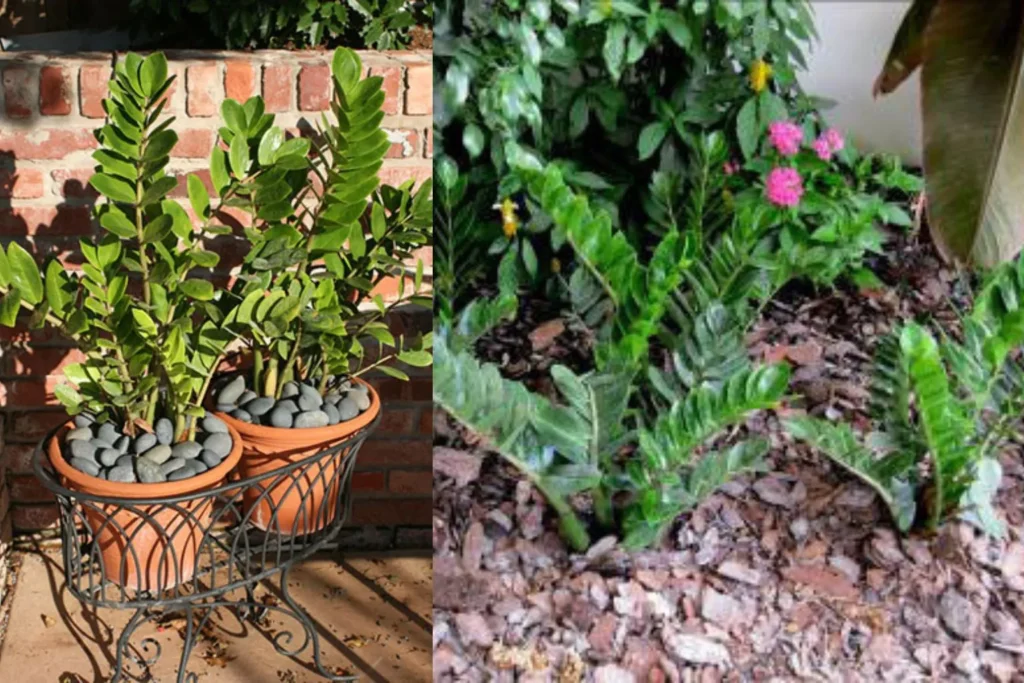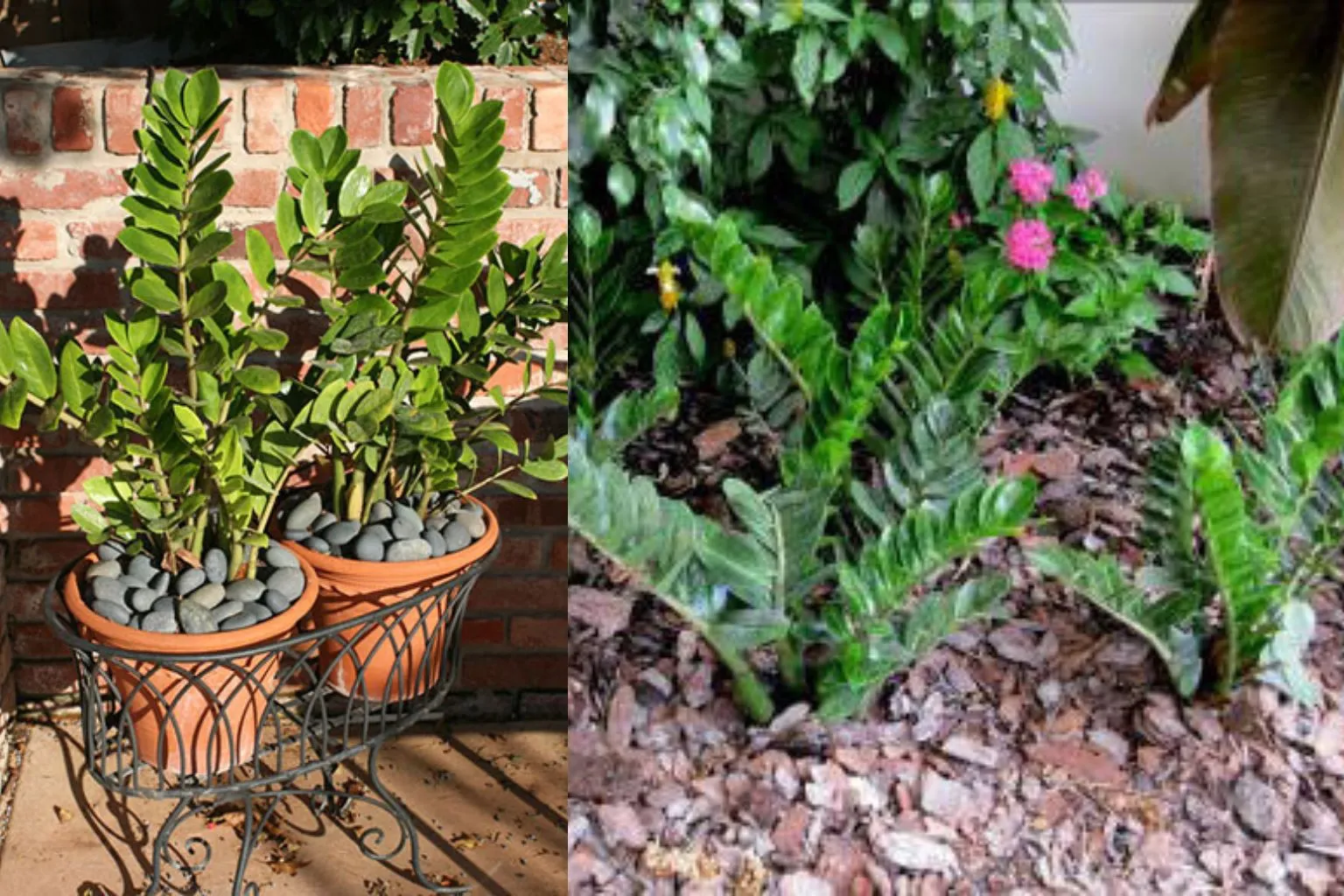The ZZ plant (Zamioculcas zamiifolia) has gained immense popularity as a popular indoor houseplant due to its striking appearance, ease of care, and ability to thrive in low light conditions.
However, as gardening enthusiasts and plant lovers explore new possibilities for incorporating plants into their outdoor spaces, a common question arises: Can a ZZ plant live outside?
In this detailed blog post, we will dive into the world of ZZ plants and explore the factors that determine their suitability for outdoor cultivation.
By the end of this article, you’ll have a clear understanding of whether your ZZ plant can flourish in the great outdoors and how to maximize its potential in an outdoor setting.

The ZZ Plant: A Brief Overview
Before we delve into the outdoor possibilities, let’s first understand what makes the ZZ plant so special.
Native to East Africa, the ZZ plant is a member of the Araceae family. Its attractive glossy green leaves are composed of several leaflets, giving it an exotic and decorative appearance.
Its ability to tolerate low light, drought, and neglect has earned it the nickname “Zanzibar Gem,” making it a popular choice for indoor spaces, offices, and homes worldwide.
Native Habitat and Environmental Adaptations
To assess the likelihood of a ZZ plant surviving outdoors, it’s crucial to understand its native habitat and natural adaptations.
In its native regions of Tanzania and Zanzibar, the ZZ plant thrives in warm, tropical climates with well-draining soil.
It often grows under the canopies of larger plants, receiving filtered sunlight. These natural adaptations provide valuable insights into its potential for outdoor cultivation.
Can a ZZ Plant Live Outside?
The short answer is yes, ZZ plants can survive outdoors under specific conditions. However, several factors must be taken into account to ensure its success.
a. Climate Suitability: ZZ plants are best suited for USDA hardiness zones 9b to 11, where temperatures remain above 25°F (-4°C). In these warmer regions, the ZZ plant can tolerate the outdoor environment more effectively.
b. Light Requirements: While ZZ plants are known for their ability to tolerate low light, outdoor conditions can vary significantly. In an outdoor setting, choose a location with indirect sunlight or dappled shade. Direct sunlight can scorch the leaves, leading to irreversible damage.
c. Soil and Drainage: The ZZ plant requires well-draining soil to prevent root rot. In outdoor settings, consider amending the soil with sand or perlite to ensure adequate drainage. Avoid waterlogged areas, as stagnant water can be detrimental to the plant’s health.
d. Temperature Extremes: While ZZ plants can tolerate heat to some extent, they are not frost-tolerant. During colder months, it is essential to protect the ZZ plant from freezing temperatures and frost.
e. Pests and Diseases: Outdoors, ZZ plants may face a different array of pests and diseases compared to indoor environments. Regularly inspect the plant for common outdoor pests like aphids, mealybugs, and spider mites.
Tips for Successful Outdoor ZZ Plant Cultivation
To ensure your ZZ plant thrives in an outdoor setting, follow these essential tips:
a. Acclimatization: If you decide to move your indoor ZZ plant outside, acclimatize it gradually. Sudden changes in light and temperature can shock the plant, leading to stress and potential health issues.
b. Container Gardening: For regions with colder climates or unsuitable soil conditions, consider container gardening. Plant the ZZ in a pot and bring it indoors during colder months.
c. Proper Watering: Strike a balance between underwatering and overwatering. ZZ plants can tolerate periods of drought, but consistent underwatering can lead to stunted growth. Water the plant when the top inch of the soil is dry.
d. Fertilization: Provide your outdoor ZZ plant with a balanced fertilizer during the growing season. Follow the recommended dosage to avoid overfeeding, which can lead to nutrient imbalances.
e. Pruning: Remove any dead or yellowing leaves promptly. Pruning will encourage healthy growth and maintain the plant’s aesthetic appeal.
f. Mulching: Mulching around the base of the ZZ plant can help retain soil moisture and regulate temperature.
Potential Benefits of Outdoor ZZ Plant Cultivation
Bringing the ZZ plant outdoors can offer several benefits:
a. Increased Size: Outdoor environments typically provide more space for plants to grow and expand, allowing your ZZ plant to reach its full potential in size.
b. Natural Air Purifier: ZZ plants are known for their air-purifying qualities. Outdoors, they can contribute to reducing air pollution and enhancing overall air quality.
c. Aesthetic Appeal: The exotic and glossy foliage of ZZ plants adds a touch of tropical elegance to any outdoor space.
d. Biodiversity Support: By cultivating ZZ plants outdoors, you create an environment that encourages biodiversity and attracts beneficial insects and birds.
FAQs:
What are the ideal outdoor conditions for a ZZ plant?
The ideal outdoor conditions for a ZZ plant include warm temperatures within USDA hardiness zones 9b to 11, where temperatures remain above 25°F (-4°C). It thrives in indirect sunlight or dappled shade, well-draining soil, and protection from frost and extreme temperature fluctuations.
Can I move my indoor ZZ plant outside during the summer?
Yes, you can move your indoor ZZ plant outside during the summer, as long as you gradually acclimate it to the outdoor environment. Start by placing it in a shaded or partially shaded area, and slowly increase its exposure to sunlight over a few days.
Can I leave my ZZ plant outdoors during the winter?
ZZ plants are not frost-tolerant, and exposing them to freezing temperatures can be detrimental to their health. If you live in a region with cold winters, it’s best to bring your ZZ plant indoors or protect it with a frost cloth or mulch during the colder months.
What type of soil is best for an outdoor ZZ plant?
A well-draining soil mix is essential for an outdoor ZZ plant. You can use a combination of regular potting soil and additives like sand, perlite, or peat moss to improve drainage. Avoid heavy, waterlogged soils that can lead to root rot.
How often should I water my outdoor ZZ plant?
ZZ plants can tolerate periods of drought, so it’s essential not to overwater them. Water the plant when the top inch of the soil is dry. The frequency of watering will depend on your local climate and weather conditions.
Should I fertilize my outdoor ZZ plant?
Yes, you should fertilize your outdoor ZZ plant during the growing season (spring and summer). Use a balanced liquid fertilizer at half the recommended strength every 4-6 weeks. Avoid overfertilization, as ZZ plants are relatively low-maintenance and can be sensitive to excess nutrients.
How can I protect my outdoor ZZ plant from pests and diseases?
Regularly inspect your outdoor ZZ plant for common pests like aphids, mealybugs, and spider mites. If you spot any infestations, treat the plant with insecticidal soap or neem oil. To prevent diseases, avoid overwatering and ensure proper soil drainage.
Can I propagate my outdoor ZZ plant?
Yes, you can propagate your outdoor ZZ plant through division. Wait for the plant to become mature and develop multiple rhizomes. Carefully separate the rhizomes and replant them in individual pots with well-draining soil.
How fast does a ZZ plant grow outdoors?
The growth rate of a ZZ plant outdoors can vary depending on environmental conditions. In ideal conditions, a ZZ plant can grow 2-3 new leaves per year. However, growth may slow down in less favorable environments.
Can I grow a ZZ plant outdoors in a colder climate?
While ZZ plants prefer warm temperatures, you can still grow them outdoors in colder climates by using container gardening. Plant the ZZ in a pot and bring it indoors during the winter months to protect it from frost and freezing temperatures.
Can I plant my ZZ plant directly in the ground outdoors?
Yes, you can plant your ZZ plant directly in the ground outdoors, provided that your local climate and soil conditions are suitable. Ensure that the planting area has good drainage and amend the soil if necessary to improve its texture and fertility.
How do I protect my outdoor ZZ plant from extreme heat?
In regions with high temperatures, provide shade for your outdoor ZZ plant during the hottest parts of the day. You can use shade cloth or plant taller vegetation nearby to provide natural shade. Additionally, ensure that the plant receives adequate water to help it withstand heat stress.
Can I grow ZZ plants outdoors in containers?
Yes, growing ZZ plants in containers is a popular option for outdoor cultivation, especially in regions with colder climates or unsuitable soil conditions. Choose a well-draining pot and use a high-quality potting mix. Container-grown ZZ plants can be moved indoors during colder months or extreme weather conditions.
How do I prune my outdoor ZZ plant?
Pruning outdoor ZZ plants is similar to indoor plants. Remove any dead or yellowing leaves by cutting them off at the base of the stem using clean, sharp pruning shears. Pruning encourages new growth and helps maintain the plant’s shape and appearance.
Can I use mulch around my outdoor ZZ plant?
Yes, applying mulch around the base of your outdoor ZZ plant can help retain soil moisture, regulate temperature, and suppress weed growth. Use organic mulches such as bark chips, shredded leaves, or compost. Apply a layer of mulch about 2-3 inches thick, taking care to leave space around the plant’s stem to prevent rot.
How do I protect my outdoor ZZ plant from pests and diseases without using chemicals?
You can prevent pest and disease problems in your outdoor ZZ plant by practicing good cultural care. This includes proper watering, avoiding over-fertilization, and maintaining overall plant health. You can also encourage natural predators like ladybugs and lacewings to control pest populations. Additionally, regularly inspect your plant for signs of pests or disease and remove affected leaves promptly.
Can I divide my outdoor ZZ plant to create new plants?
Yes, you can divide mature outdoor ZZ plants to create new plants. Wait until the plant has developed multiple rhizomes, then carefully dig up the plant and separate the rhizomes using a clean, sharp knife or pruning shears. Replant the divided rhizomes in individual pots or directly in the ground, ensuring that each division has roots attached.
Will outdoor ZZ plants flower?
While ZZ plants can produce small, inconspicuous flowers under certain conditions, flowering is relatively rare, especially when grown outdoors. The primary appeal of ZZ plants lies in their attractive foliage rather than their flowers.
Can I grow other plants alongside my outdoor ZZ plant?
Yes, ZZ plants can be combined with a variety of other plants in outdoor garden beds or containers. Choose companion plants that have similar light and water requirements to ensure compatibility. Succulents, ferns, snake plants, and philodendrons are some options that pair well with ZZ plants.
How do I overwinter my outdoor ZZ plant?
If you live in a region with cold winters, you’ll need to protect your outdoor ZZ plant from frost and freezing temperatures during the winter months. Consider bringing potted ZZ plants indoors or covering outdoor plants with frost cloth or blankets on chilly nights. Mulching around the base of the plant can also help insulate the roots and protect against cold damage.
Conclusion
In conclusion, the ZZ plant can indeed thrive outdoors under specific conditions.
By considering its native habitat, climatic requirements, light preferences, and soil needs, you can successfully grow a ZZ plant in your outdoor space.
Whether you live in a warm tropical climate or need to protect your ZZ from colder temperatures, with proper care and attention, you can enjoy the beauty and benefits of this remarkable plant in your garden or patio. Happy gardening!


I have had ZZ plants for at least ten years. I propagate by pulling out of pot cutting the plant and soil in half and then repotting in premium potting mix. The pots are outdoors in shade of a Eucalypt with shrubbery protecting from Western Afternoon sun. One plant ten years ago had been divided approx 80 to 100 times. One failure in that time plus those placed into ground are less than successful but still alive. I think drainage is key. My soil is 500mm of loam on top of Yellow Clay. Those in pots thrive. Although all the instructions say beware of over watering my garden gets between 970mm and 1500mm ( 40-60”) per year.
I will add some photo’s to this post later in day.
Sure, please share some photos.